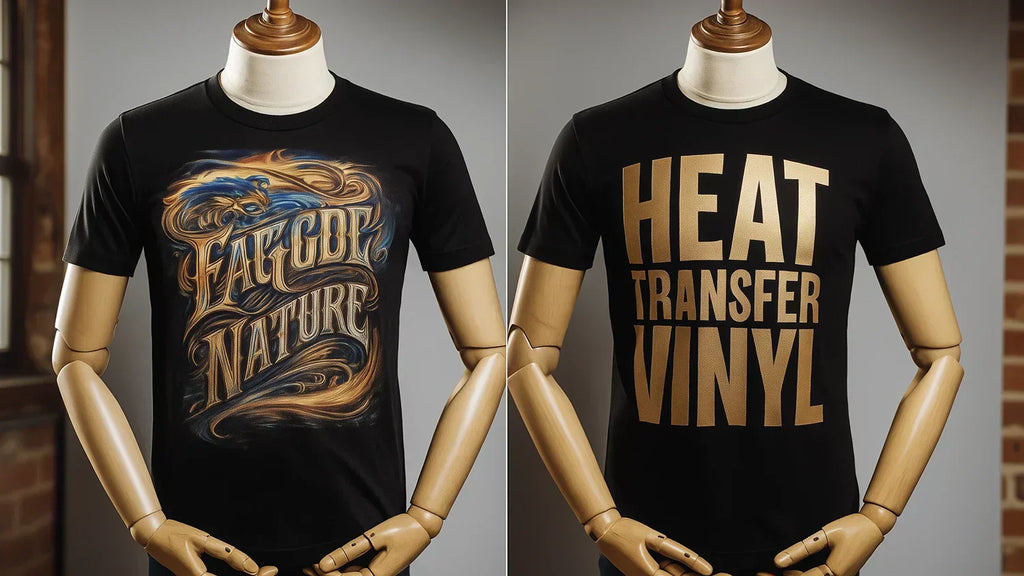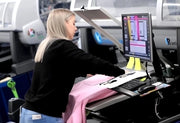🔥 Heat Transfer Vinyl (HTV) vs DTF: What’s the Difference?

HTV vs DTF: Which is Right for You?
The world of custom t-shirt printing has come a long way since the early days of iron-on transfers. Traditional heat transfers—once a go-to choice for novelty tees and basic promotional wear—are now being surpassed by more advanced solutions, such as DTF (Direct-to-Film). As printing demands have evolved, so has the technology, giving creators and businesses better tools for sharper results, stronger durability, and wider material compatibility.
DTF printing has rapidly become a favourite for high-quality printed clothing thanks to its ability to reproduce bold, vibrant designs with impressive longevity. But is it always the better choice? And how does it compare to traditional heat transfers in terms of cost, usability, and finish?
This article compares heat transfer and DTF based on durability, colour performance, and cost so that you can choose the correct process for your next customised t-shirt printing project.
🎨 What Is Heat Transfer Vinyl?
Heat transfer vinyl printing is one of the oldest and most accessible ways to customise clothing. It typically involves printing a design onto heat transfer paper or cutting vinyl into shapes or text, then bonding it to fabric using heat and pressure. This method gained popularity in the DIY space but is still widely used today for specific finishes and low-volume production.

It’s especially common in basic custom t-shirt printing setups, where speed and cost matter more than long-term durability. While it lacks the softness and photographic detail of DTG or DTF, it can still be a great option for one-off designs, slogan tees, and artwork featuring bold text. Vinyl also enables special effects, such as metallic, glitter, and neon finishes, that other methods often struggle to reproduce.
Heat Transfer Pros & Cons at a Glance
| ✅ Pros | ❌ Cons |
|---|---|
| Low setup cost | Can crack or peel with repeated washing |
| Ideal for basic logos, slogans, and text | Limited stretchability and flexibility |
| Can create metallic, glitter, and neon finishes | Not suitable for full-colour photographic designs |
| Quick for one-offs and small batch production | Often has a heavier hand feel |
| Works well on most fabrics, including polyester and blends | May not deliver retail-level softness or feel |
Due to its simplicity and flexibility, heat transfer printing remains a valuable option for many creators. If you're producing fun, bold graphics or personalised printed t-shirts with standout effects, it's a practical and cost-effective method. But for detailed artwork, soft finishes, or long-term retail use, other print techniques may deliver better results.
⚡ What Is DTF (Direct to Film) Printing?
DTF, or Direct-to-Film printing, is a modern method that bridges the gap between screen printing and DTG. Instead of printing directly onto the fabric, the design is first printed onto a special film. This print is then coated in a powdered adhesive, cured, and finally heat pressed onto the garment, creating a flexible, full-colour finish that bonds to a wide range of materials.
One of the biggest advantages of DTF is its flexibility with fabrics. It works well on cotton, polyester, synthetic blends, and other tricky materials where DTG often falls short. That makes it a practical choice for producing custom hoodies, custom printed t-shirts, and all kinds of promotional wear. Designs are vibrant, detailed, and have fair durability, especially when compared to older heat transfer methods.
DTF Pros & Cons at a Glance
| ✅ Pros | ❌ Cons |
|---|---|
| Prints on cotton, polyester, blends, and synthetics | Requires specialist film, adhesive, and curing equipment |
| Ideal for full-colour designs with high detail | Some learning curve for consistent transfer quality |
| Fair durability (compared to basic heat transfers) | Slightly less breathable than DTG on large areas |
| No printer required when using pre-printed transfer sheets | May leave a faint outline if not heat-pressed cleanly |
| Efficient for bulk production and small runs alike | Not ideal for textured or heavily ribbed fabrics |
At The T-Shirt Bakery, we handle the hard part for you. We take your design and print it onto premium DTF transfer sheets in-house, then ship them out for you to apply using a standard heat press. It’s a practical, lower-risk way to get into garment decoration—without investing in specialist equipment or years of experience. For anyone serious about t-shirt printing in the UK—especially at scale—DTF is a smart, futureproof investment.
DTF printing has established itself as a flexible, mid-tier solution in modern garment decoration. While it may not match the softness of DTG or the longevity of screen printing, it opens the door for high-quality, full-colour results across a range of fabrics. For startups, events, and personalised printed t-shirts, it’s a reliable way to scale without sacrificing quality or breaking the bank.
💸 Cost & Durability: DTF vs Heat Transfer Vinyl
When it comes to transfer printing methods, both DTF sheets and heat transfer vinyl offer fast, accessible ways to customise garments without huge setup costs. But which one works best for your budget, your artwork, and the way your customers use their clothing?
Durability-wise, both are solid, but neither is invincible. If applied properly and cared for correctly, you can expect around 30–40 washes from both DTF and vinyl. Both can crack, fade, or peel over time, especially when subjected to frequent stretching, heavy tumble drying, or improper application technique. DTF might feel a touch more forgiving on blended fabrics, but it’s not a game-changer for longevity. They’re both transfers at the end of the day.
🆚 Quick Comparison: DTF vs Heat Transfer Vinyl
| Feature | Heat Transfer Vinyl | DTF Transfer Sheets |
|---|---|---|
| Material Cost (55×100 cm) | ~£15.00 | £19.99 |
| Setup Process | Cut + Weed + Press | Press-Only |
| Output Speed | Slower for batch jobs | Faster for repeat jobs |
| Durability | Fair — cracks/peels with time | Fair — cracks/peels with time |
| Suitable For | Text, one-offs, metallic/glitter | Graphics, illustrations & photographs |
| Scaling | Manual effort increases | Suits print-on-demand and batch runs |
Vinyl is slightly cheaper (around £15.00 per 55×100 cm) but slower to apply, as it requires you to cut, weed, and press each design. DTF sheets cost around £19.99 but skip straight to pressing—making them faster for bulk orders. Vinyl is great for bold text and speciality finishes like metallics, glitter, and neon. Meanwhile, DTF stands out for its full-colour graphics, logos, and gradients—especially when time and scalability are a concern.
🤔 Final Thoughts
Heat transfer vinyl and DTF are both practical choices for applying custom designs without the cost or complexity of full-scale screen printing. They’re affordable, compact, and ideal for creators looking to launch or scale personalised apparel —from startup brands to merch creators and event teams. But they suit different strengths.
DTF works best when speed and detail matter. It fits seamlessly into batch production or print-on-demand workflows, especially if you need multi-colour prints or photo-quality artwork. You simply press and go. Vinyl, on the other hand, is great for one-off items, bold slogans, or when you want eye-catching finishes like metallic and glitter effects. It’s more manual, but creatively versatile.
Both methods have their place. Choosing between them comes down to your artwork, timeline, and how you plan to fulfil your orders. If you’re experimenting, try both. At The T-Shirt Bakery, we print DTF transfer sheets to order—so you can test your prints without committing to bulk runs or expensive gear.
❓ FAQs: Heat Transfer Vinyl vs DTF Printing
Your top questions answered on print quality, speed, cost, and when to choose vinyl or DTF.
🧵 What’s the biggest difference between heat transfer and DTF printing?
If you're after bold text or metallic effects, vinyl is ideal. For photo-quality artwork, DTF transfer sheets give sharper, more scalable results.
💸 Which is cheaper overall for a startup?
If you're running a t-shirt printing business, time saved per order can make a huge difference to your margin.
🎨 Which is better for colour and detail?
👚 Can I use both methods on any fabric?
To learn more about fabric compatibility, check our DTG vs DTF vs Screen Printing guide.











